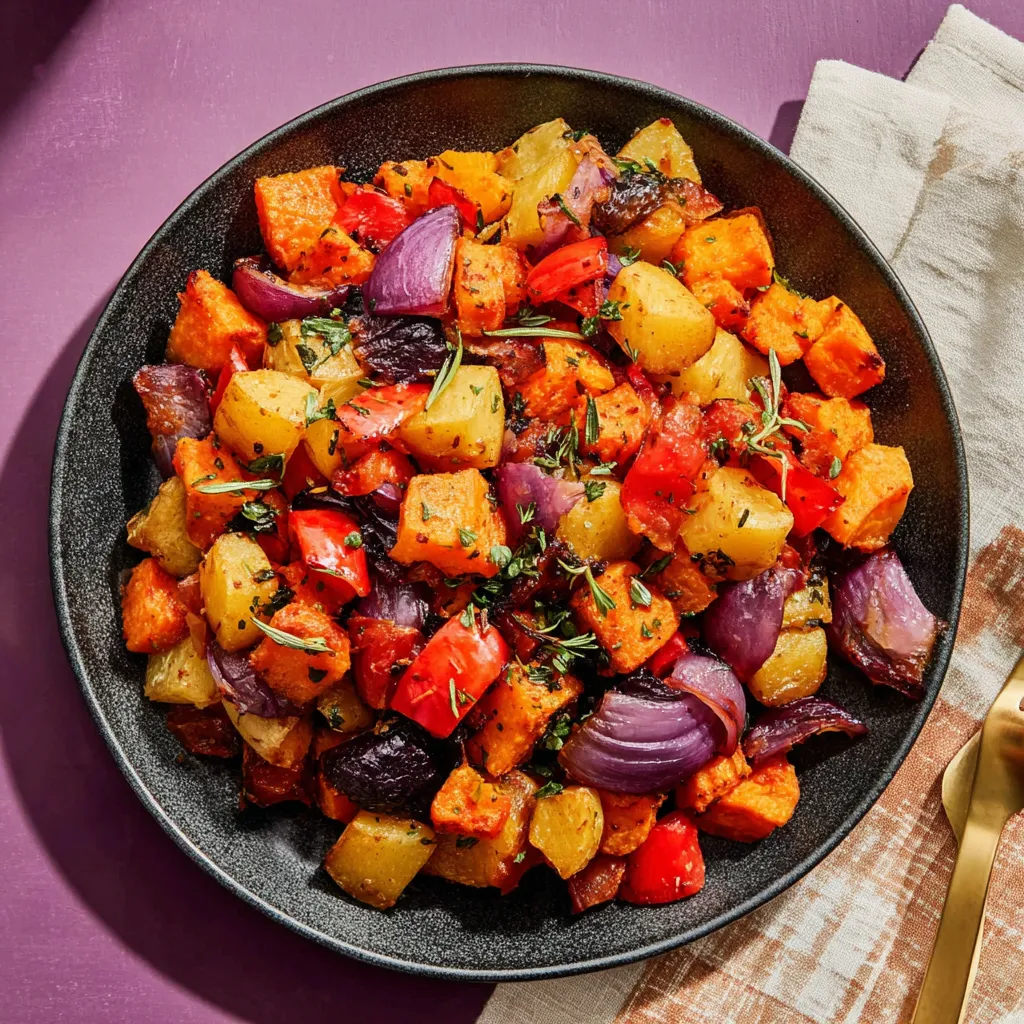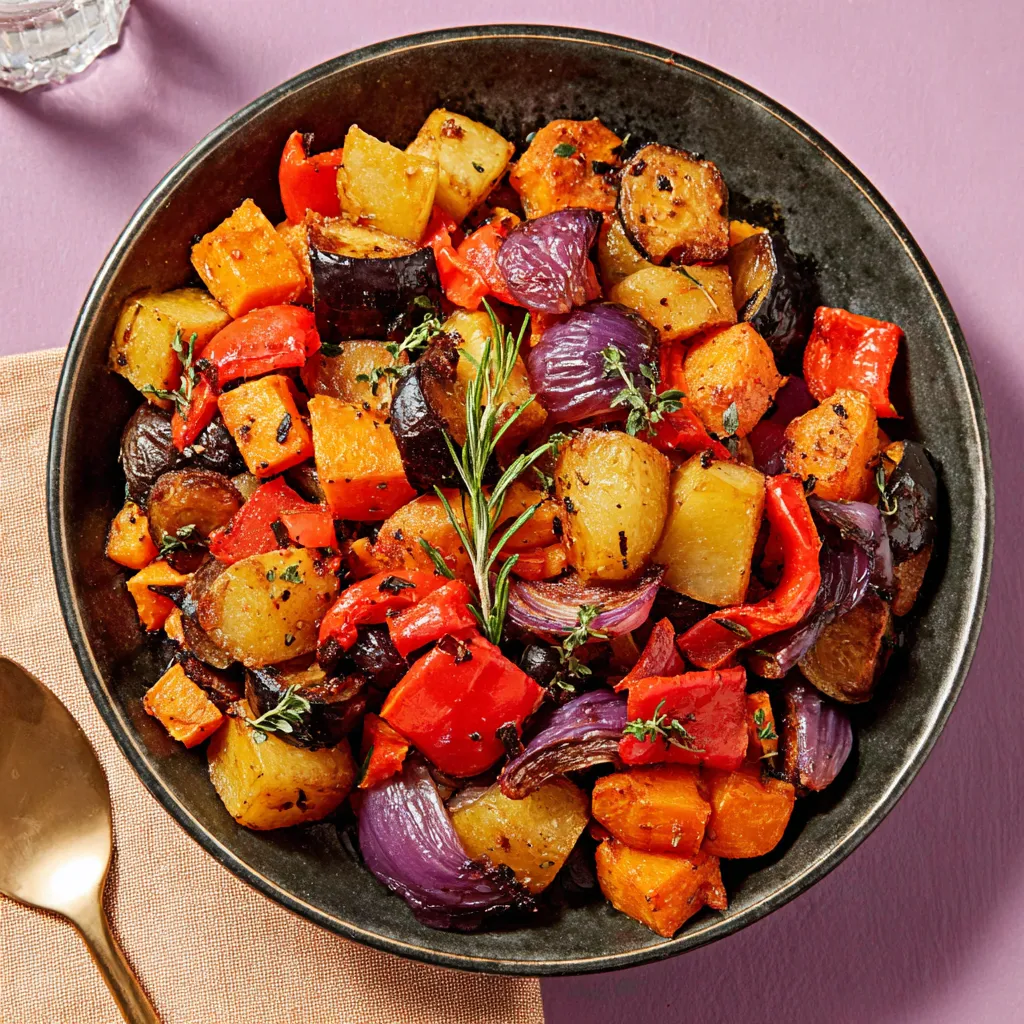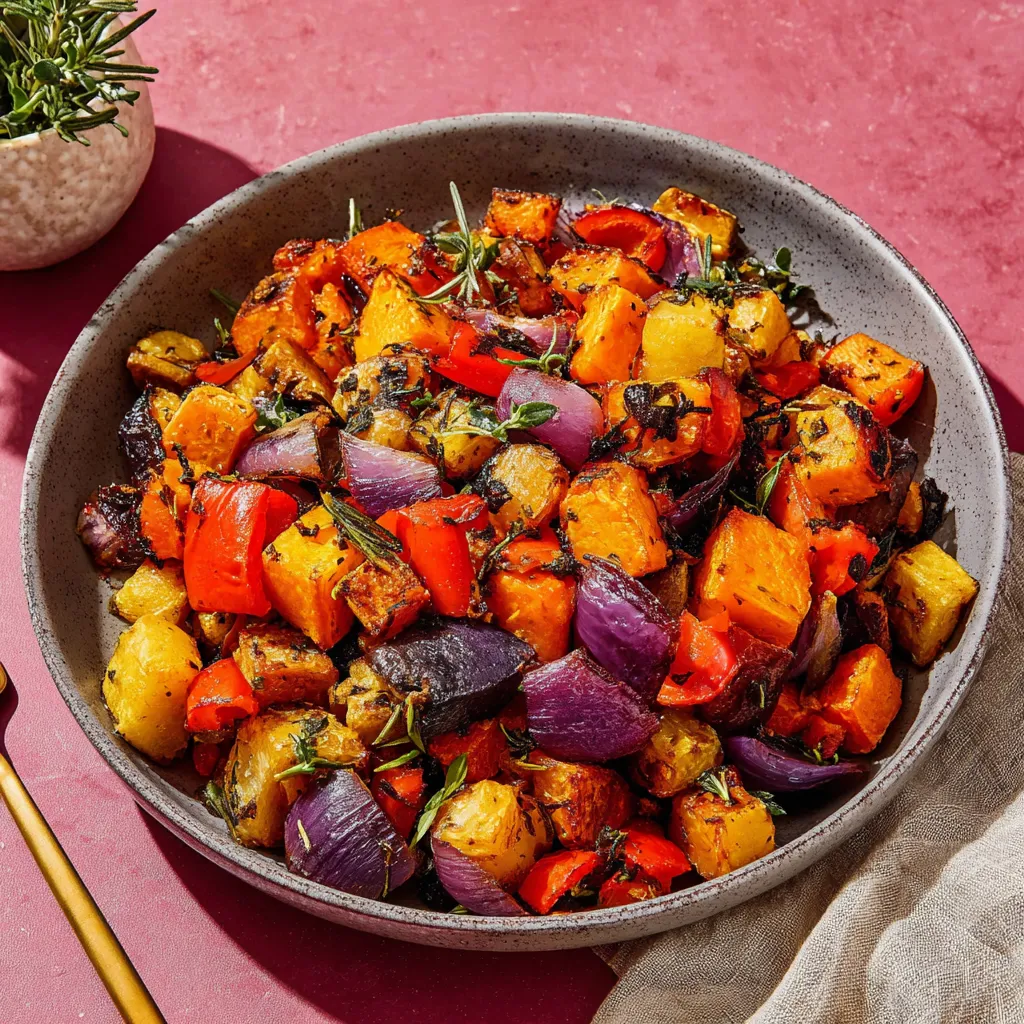 Save
Save
This colorful medley of roasted vegetables has been my go-to side dish for years, transforming ordinary meals into something special with minimal effort. The magic happens when the natural sugars caramelize in the oven, creating a delicious depth of flavor that makes even vegetable skeptics reach for seconds.
I first made this recipe when hosting my first Thanksgiving dinner, nervously trying to please both vegetarians and meat-eaters. Now it appears on our table at least weekly, and guests always ask for the recipe.
Ingredients
- Butternut squash brings natural sweetness and a velvety texture when roasted
- Yukon Gold potatoes offer a buttery flavor and hold their shape beautifully
- Red bell peppers add vibrant color and become incredibly sweet when caramelized
- Sweet potato contributes a different texture and nutritional boost
- Red onion pieces become jammy and aromatic when roasted
- Olive oil helps achieve that perfect golden exterior
- Balsamic vinegar adds complexity and helps caramelize the vegetables
- Fresh rosemary infuses woodsy, aromatic notes throughout
- Fresh thyme provides earthy, slightly lemony undertones
- Salt and pepper enhance all the natural flavors
Step-by-Step Instructions
- Preheat Oven
- Heat your oven to 475°F (245°C) which ensures quick caramelization without mushiness. Position your rack in the middle of the oven for even cooking.
- Prepare Vegetables
- Cut all vegetables into uniform 1/2-inch pieces to ensure they cook at the same rate. The red onion should be quartered and separated into pieces rather than diced to prevent burning.
- Create Seasoning Mixture
- Combine olive oil, balsamic vinegar, fresh chopped rosemary and thyme in a small bowl. This mixture creates the perfect coating that will help vegetables caramelize while infusing them with herb flavor.
- Coat Vegetables
- Pour the seasoning mixture over your prepared vegetables and toss thoroughly until every piece is glistening with the herb-infused oil. Take your time here as proper coating ensures even flavor.
- Arrange for Roasting
- Transfer the seasoned vegetables to a large roasting pan, spreading them in a single layer. Overcrowding leads to steaming rather than roasting, so use two pans if necessary.
- Roast with Attention
- Roast for 35-40 minutes, stirring every 10 minutes to promote even browning. Look for caramelized edges and fork-tender centers before removing from the oven.
 Save
Save
The balsamic vinegar is my secret weapon in this recipe. My grandmother always said a touch of acidity brings vegetables to life, and she was absolutely right. I remember watching her splash a bit of vinegar into her roasting pan when I was young, amazed at how something so simple could make such a difference.
Perfect Temperature Matters
Roasting at high heat (475°F) is crucial for developing the caramelized exterior while maintaining a tender interior. If your vegetables are steaming rather than roasting, your oven temperature may be too low or your pan may be overcrowded. Always preheat thoroughly and give your vegetables plenty of space to brown properly.
Seasonal Adaptations
This recipe welcomes substitutions based on what looks best at the market. In spring, try asparagus, spring onions, and radishes (added halfway through cooking). Summer calls for zucchini, eggplant, and cherry tomatoes (add tomatoes in the final 10 minutes). Fall and winter are perfect for parsnips, Brussels sprouts, and winter squashes as written in the original recipe.
Serving Suggestions
Serve these roasted vegetables alongside roasted chicken or grilled fish for a complete meal. They also make an excellent base for grain bowls topped with a fried egg or crumbled cheese. For elegant presentation, arrange them on a platter and drizzle with herb oil or aged balsamic vinegar before serving.
Storage and Reheating
Store leftovers in an airtight container in the refrigerator for up to 5 days. To reheat, spread in a single layer on a baking sheet and warm in a 350°F oven for 10-15 minutes until heated through. Avoid microwave reheating which can make the vegetables soggy. For best results, bring to room temperature before reheating.
 Save
Save
Recipe FAQs
- → Can I use different vegetables in this dish?
Absolutely! While the recipe specifies butternut squash, Yukon Gold potatoes, red bell peppers, sweet potato, and red onion, you can substitute with vegetables of similar density. Good alternatives include carrots, parsnips, Brussels sprouts, cauliflower, or zucchini (add zucchini later in the cooking process as it cooks faster).
- → How do I store leftover roasted vegetables?
Store leftover roasted vegetables in an airtight container in the refrigerator for up to 4 days. They can be reheated in a 350°F oven for 10-15 minutes or in a microwave. Leftover vegetables also work well in grain bowls, salads, or frittatas.
- → Can I make these vegetables ahead of time?
Yes! You can prepare these vegetables up to 2 days ahead. Either roast them completely and reheat before serving, or prep all vegetables, toss with the oil mixture, and refrigerate. When ready to cook, spread on the roasting pan and follow the baking instructions.
- → What's the best way to achieve caramelization?
For optimal caramelization, ensure your oven is fully preheated to 475°F, don't overcrowd the vegetables on the pan (use two pans if necessary), cut vegetables into uniform sizes, and stir only every 10 minutes as specified. The high temperature and balsamic vinegar both contribute to beautiful caramelization.
- → What can I serve with these roasted vegetables?
These versatile roasted vegetables pair wonderfully with roasted chicken, grilled steak, baked fish, or pork tenderloin. They also complement grain dishes like quinoa or farro, and make an excellent addition to holiday meals alongside turkey or ham.
- → Can I use dried herbs instead of fresh?
While fresh herbs provide the best flavor, you can substitute dried herbs if necessary. Use 2 teaspoons dried rosemary and 1 teaspoon dried thyme instead of the fresh amounts. Add dried herbs to the oil mixture as directed in the original recipe.
